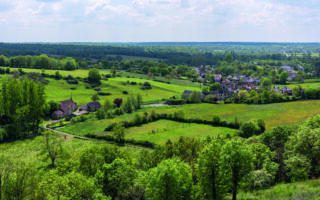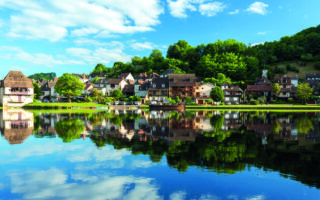Eco Home Stars on Grand Designs

Daren and Adi built a home in Brittany from recycled materials and were filmed for Channel 4 TV series Grand Designs. Here, Adi talks FrenchEntrée through their eco-friendly project, from planning permission to energy saving appliances and top tips for building abroad…
So Adi, what attracted you to France and Brittany in particular?
It was Daren who first discovered the stunning Brittany countryside about 12 years ago. He travelled around the world looking for a place to build a home. He completely fell in love with the rich history, the ancient megalithic sites, the natural beauty and the friendly people in the heart of Brittany.
How long was your search for the perfect plot and what did it consist of?
He spent about two years looking in various countries, but once he settled on Brittany it only took about four months. He was lucky enough to stumble across the ruined village of Kernombre. It was not for sale at the time, but after several discussions with the old lady who lived there as a child, he was able to negotiate to buy the village. It consisted of the footings of a very old castle and several other ruins, including the old stone cottage – now called Plumstone Cottage, with a tree growing straight through the middle of it – plus four acres of land with a sweet chestnut wood, massive rock formations and a stream with trout in it.
How did the Grand Designs team get to hear about your project?
Daren was a guest speaker at Grand Designs live in 2007, talking about his business CLEVEL and Carbon Balancing. Kevin McCloud was chairing the talks and Daren shared the fact that he had secured planning permission to build Brittany Groundhouse. Kevin had been following Daren’s earlier projects and asked if he could come and film it.
What was Kevin McCloud like?
Very much as he comes across on television, witty and knowledgeable about building with a genuine passion for innovation and natural design, up for a laugh and always a gentleman!
Did you have any previous experience of building/renovating a property?
Daren had already renovated Plumstone Cottage. I had worked on a project in South Africa making mudbricks to build a natural home and had been dreaming of building one!
 Did you encounter a lot of red tape in terms of planning permission etc in France?
Did you encounter a lot of red tape in terms of planning permission etc in France?
The process was actually relatively straight forward, but took over a year to go through. We had to prove to the local council why our Groundhouse would be a valuable demonstration of sustainable architecture. The main issue were the codes that prevent enlargement of the small villages like Kernombre, but everyone was supportive – keen to enable the project to go ahead.
How long was the building project – did it take longer and cost more than you thought?
We spent a year building most of it, and a second year finishing it off… so it took about six months longer than we thought and spent about 20% more than expected.
Why was it so important to you that the house was eco-friendly?
Daren and I are passionate about living in a less impactful way on the Earth and being careful not to overuse the resources we have available to us. Living in a zero carbon home is a big opportunity to reduce our carbon footprint. But the reality is that the house we built is easier to live in, more comfortable and feels better than any other we have lived in.
Talk us through some of the energy saving appliances / salvaged materials in the house…
The solar panels produce electricity sold back to the grid. The house is heated and cooled using the sun. Most water for washing can be harvested from the rain and is heated through the solar hot water system.
The house is orientated to the South and is light and warm all year round. Its passive solar design and rammed earth walls ensure it keeps a near constant temperature without the need for central heating. All of this means that the house is almost entirely free of bills.
We used a lot of salvaged materials to build the house, including 1000 tyres for holding all the rammed earth in the walls! Other main ingredients are the glass bottles in our mosaic walls, sea-worn oak for our kitchen counters, 1000 cardboard boxes and stones from the castle ruins, which we excavated from the site.
 What was locally sourced?
What was locally sourced?
We worked with a number of local craftsmen. All the earth and sand were local and these accounted for the bulk of materials. The wood came from the local sawmill and the empty wine and beer bottles from our neighbours and the local pub!
What is your favourite aspect of the design?
It is so light and spacious and there is this beautiful flow to the whole house as all the rooms are on one level and hardly any corners.
Did you always intend to run a gîte business in France?
No, but we have relocated to the UK because of Daren’s children. Having made that decision, we wanted to offer the house to rent as a good way to continue sharing the philosophy and performance of the house.
Around 80% of the people who have stayed came to our Greengite business looking for a luxurious and unusual place to stay, but the other 20% have come to experience living in the house before embarking on their own eco-builds.
How do you like to spend your time in Brittany?
Relaxing at the Groundhouse, going for walks, cycling and swimming in the nearby lake or walking through its forests, watching Breton music or joining in at a Festnoz, sipping wine and eating pizza from the Pizza Caravan in Mellionnec.
Do you have any tips for others wishing to build their own home in France?
Learn as much of the language as you can in advance and continue to work on it while you are here. Using the French we had with people made such a difference. Accept any social invitations and invite your neighbours round for drinks or coffee. Fall in with the French rhythm of doing things, it’s a much more relaxed pace and will mean that you are in sync. For example, have your lunch at the same time as the French do and work a similar working day. Finally, if you are going to a rural area, pick an area that has a good culture and great people.
- Groundhouse Build + Cook has been written by Daren Howarth and Adi Nortje, with a foreword by Kevin McCloud. This illustrated book shows how to build an eco home and includes 30 recipes inspired by Brittany.
Share to: Facebook Twitter LinkedIn Email
More in businesses, children, renovation, villages, wine
Leave a reply
Your email address will not be published. Required fields are marked *



